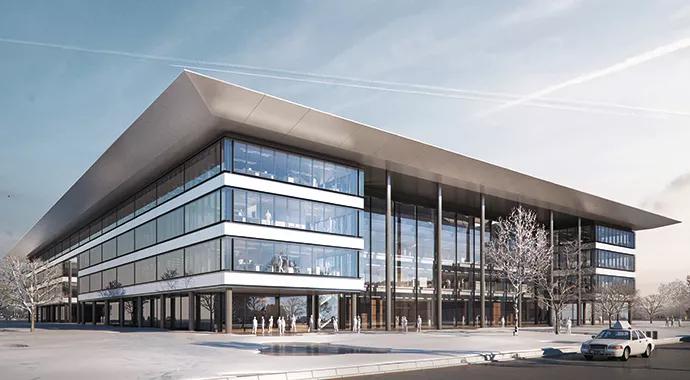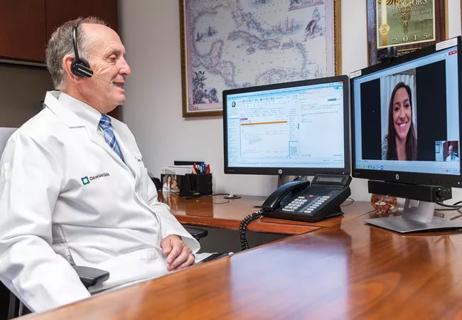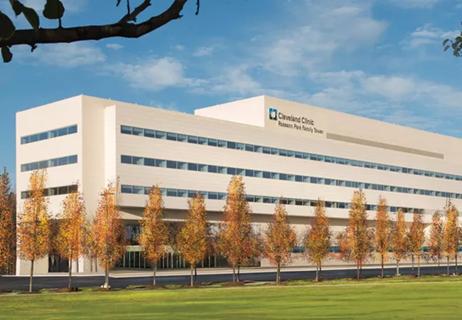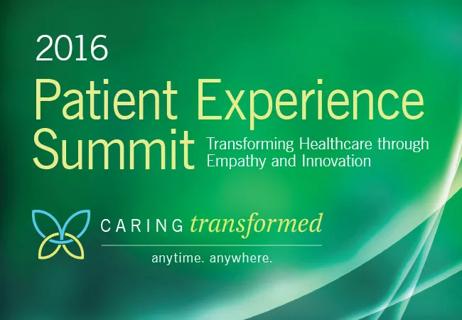State-of-the-art facility is collaboration of Case Western Reserve University and Cleveland Clinic

Case Western Reserve University and Cleveland Clinic are expanding their health education collaboration to include dental and nursing students on the campus already planned for the institutions’ medical students. The news comes as the university and hospital system submitted designs and renderings for the 485,000-square-foot quadrangle building to the Cleveland City Planning Commission in advance of meetings next week. The world-renowned architecture firm Foster + Partners designed the Health Education Campus to stand on the same 11-acre parcel originally designated for the medical education building.
Cleveland Clinic is a non-profit academic medical center. Advertising on our site helps support our mission. We do not endorse non-Cleveland Clinic products or services. Policy
Located on East 93rd Street between Euclid and Chester Avenues, it will include even more of the cutting-edge technology and innovative learning spaces previously planned for medical education. “Studies show that team-based health care improves patients’ experiences and results, lowers costs, and increases the job satisfaction of those involved in care,” Case Western Reserve President Barbara R. Snyder said. “Yet most of our education programs still separate the professions throughout students’ academic careers. This project allows us to bring these future health care leaders together from the very start, and to do so in a thoughtful and intentional way.”
The soaring, state-of-the-art space is expressly designed to encourage interaction among all students – not only in classrooms, but in dining and study areas as well. The goal is for students to graduate with a deeper understanding of how these caregivers complement one another’s work – as well as appreciation for the unique roles each plays in enhanced outcomes for patients.
“Healthcare is in the midst of an unprecedented transformation and is changing how we deliver care to patients and how we get reimbursed for services. The focus is now on quality and outcomes for patients, while moving away from fee for services,” said Cleveland Clinic President and CEO Toby Cosgrove, M.D. “This requires a team of providers – with a variety of expertise and experience – working together to care for patients and why an integrated medical education program is not just important, but essential.”
Teams from the two institutions are continuing to finalize estimates for the cost of the expanded project, which is now roughly 300,000 square feet larger than its original design. They also are working to determine optimal timelines for commencing and completing construction.
Meanwhile, to keep the project moving forward as expeditiously as possible, the exterior designs, streetscapes and landscaping plans will go before the Euclid Corridor Design Review Committee Thursday, Dec. 4 and the planning commission Friday, Dec. 5 as part of the approval and permit process.
The four-story building’s academic spaces and offices wrap around a soaring, airy atrium where students, faculty and staff can gather for meals and conversation. All of the furniture in the space is movable, so the atrium also can host large events such as lectures, convocations, banquets and the like. The structure is designed to be as energy efficient and environmentally friendly as possible. At minimum, the building will meet LEED Silver environmental building standards. In addition to Foster + Partners, local architects Westlake Reed Leskosky also are involved with the project.
“This is a stunning building whose design will inspire every person who enters,” said Pamela B. Davis, M.D., Ph.D., Dean of the School of Medicine and Senior Vice President for Medical Affairs at the university. “Starting with the large, airy atrium, every detail encourages interaction and the exchange of ideas. We cannot wait to see the creativity and innovation that emerges when all of our students and faculty begin to work in this extraordinary space.”
Case Western Reserve’s dental medicine and nursing programs together enroll just over 1,500 students, while the medical school’s M.D. tracks total nearly 1,000. The Cleveland Clinic Lerner College of Medicine track enrolls 160 of these students, with the remainder in the university’s M.D. and M.D.-Ph.D. tracks. The medical school also plans to add a physician’s assistant program that will grow to enroll 100 students, all of whom also would learn on the new campus.
Over the past several months, leaders from the two medical school tracks and the dental and nursing programs have collaborated to determine how best to structure the space to encourage extensive integration. At the same time, they have focused on addressing the unique needs of each program. Dental medicine students, for example, participate in a school-based dental clinic in their third and fourth years. This dental clinic – where students treat patients under the guidance of faculty – will be housed within the new campus.
“Collaboration among the professions is the key to improving health care in the 21st century,” School of Dental Medicine Kenneth B. Chance, D.D.S., said. “This project gives us an extraordinary opportunity to provide all of our students the kinds of experiences that will allow them to excel in this rapidly evolving landscape.”
Case Western Reserve and Cleveland Clinic initially selected the 11-acre parcel in part to allow room for expansion of educational programs in buildings located on the same site. Even if subsequent programs later located adjacent to the medical education building, however, the structures still would have been separate – physically perpetuating the silos that keep students apart.
“We said from the start that we want to build the future of health care education,” said Jim Young, M.D., Executive Dean of the Cleveland Clinic Lerner College of Medicine. “Including nursing and dental medicine in this magnificent structure gives us the opportunity to deliver on that promise in even broader and better ways. The concept makes too much sense for us to miss the opportunity that exists right now.”
Both the nursing and dental schools occupy squat, concrete buildings originally built in 1967. Under the new model, each program’s research initiatives would stay on the main campus, as would those of the university’s medical school. The project will include an extensive shuttle system between the main campus and the Health Education Campus for faculty, staff and students.
“This project provides exceptional opportunities for students from across the health care spectrum to interact and learn from one another in settings that mirror their professional lives after graduation,” said Frances Payne Bolton School of Nursing Dean Mary Kerr, Ph.D., RN. “This approach enables our students to discover their roles not only as distinct health care providers but also as valued team members. I can’t wait to see the way this campus influences learning across these disciplines and ultimately improves patient care.”
Along with the Jack, Joseph and Morton Mandel School of Applied Social Sciences, the three schools already participate in educational collaborations for individual case study sessions and lectures. In addition, medical, nursing and social work students volunteer together at the Free Medical Clinic of Greater Cleveland. The social work students will not move from their existing location on the corner of Bellflower and Ford roads, but leaders will continue to seek ways to expand participation from that program as well.
In addition to the enormous opportunities the project creates to enhance teaching and learning, it also holds promise in terms of synergies among the respective programs. Collaboration within the region’s health-oriented entities has been growing steadily in recent years. For example, the Case Comprehensive Cancer Center – which includes the university, Cleveland Clinic and University Hospitals – last year won an “outstanding” rating from the National Cancer Institute (NCI) and continues its standing as one of just 41 centers to receive the NCI’s highest designation.
Meanwhile, the Clinical and Translational Science Collaborative, which includes those three institutions as well as MetroHealth Medical Center and the Louis Stokes VA Medical Center – has brought more than $128 million in federal grant support to the region in recent years.
Furthermore, Cleveland Clinic’s partnership with Ohio University’s Heritage College of Osteopathic Medicine, continues on schedule with students set to enroll at its extension campus in 2015 at South Pointe Hospital. And last month Cleveland Clinic, Akron Children’s and MetroHealth announced an innovative pediatric partnership in which specialists at the first two hospitals will see patients at MetroHealth.
In addition, the Case Western Reserve medical school’s primary affiliation with University Hospital Case Medical Center (UHCMC) remains in place, as do its cooperative arrangements with Cleveland Clinic, University Hospitals Health System, MetroHealth Medical Center and the Louis Stokes VA Medical Center. The nursing and dental school programs with UHCMC and others continue as well.
Founded in 1843, Case Western Reserve University School of Medicine is the largest medical research institution in Ohio and is among the nation’s top medical schools for research funding from the National Institutes of Health. The School of Medicine is recognized throughout the international medical community for outstanding achievements in teaching.
The School’s innovative and pioneering Western Reserve2 curriculum interweaves four themes–research and scholarship, clinical mastery, leadership, and civic professionalism–to prepare students for the practice of evidence-based medicine in the rapidly changing health care environment of the 21st century. Eleven Nobel Laureates have been affiliated with the school.
The School of Medicine ranks in the top 25 among U.S. research-oriented medical schools as designated by U.S. News & World Report’s “Guide to Graduate Education.” The School of Medicine’s primary affiliate is University Hospitals Case Medical Center and is additionally affiliated with MetroHealth Medical Center, the Louis Stokes Cleveland Department of Veterans Affairs Medical Center, and the Cleveland Clinic, with which it established the Cleveland Clinic Lerner College of Medicine of Case Western Reserve University in 2002.
Cleveland Clinic is a nonprofit multispecialty academic medical center that integrates clinical and hospital care with research and education. Located in Cleveland, Ohio, it was founded in 1921 by four renowned physicians with a vision of providing outstanding patient care based upon the principles of cooperation, compassion and innovation.
Cleveland Clinic has pioneered many medical breakthroughs, including coronary artery bypass surgery and the first face transplant in the United States. U.S.News & World Report consistently names Cleveland Clinic as one of the nation’s best hospitals in its annual “America’s Best Hospitals” survey.
More than 3,000 full-time salaried physicians and researchers and 11,000 nurses represent 120 medical specialties and subspecialties. The Cleveland Clinic health system includes a main campus near downtown Cleveland, eight community hospitals, more than 75 Northern Ohio outpatient locations, including 16 full-service Family Health Centers, Cleveland Clinic Florida, the Lou Ruvo Center for Brain Health in Las Vegas, Cleveland Clinic Canada, and, scheduled to begin seeing patients in 2015, Cleveland Clinic Abu Dhabi.
In 2012, there were 5.1 million outpatient visits throughout the Cleveland Clinic health system and 157,000 hospital admissions. Patients came for treatment from every state and from more than 130 countries. Follow us on Twitter.
Editor’s Note: Cleveland Clinic News Service is available to provide broadcast-quality interviews and B-roll upon request.

Women most likely to move past hesitancy upon advice by their doctors

Substantial increase in outpatient virtual visits in 2019

How we are empowering caregivers

Not all physician burnout is the same

Several clinical studies underway at Cleveland Clinic

5 noteworthy details about Avon Hospital

Key Takeaways from Day 4 at 2016 Event in Cleveland

Key Takeaways from Day 3 at 2016 Event in Cleveland